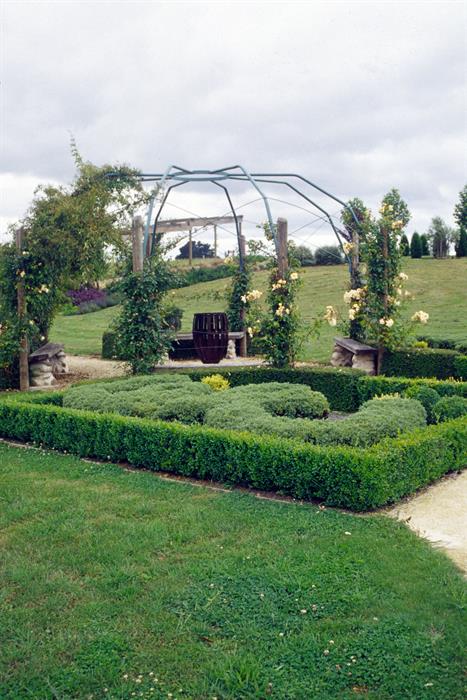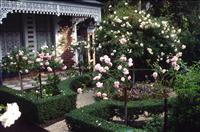Learn about the history of the Rose and study growing, propagation, culture and much more.
 Roses, often referred to as 'The Queen of the Garden', are one of the most popular and prized ornamental plants. They are included in the greatest gardens in the world and many claim roses to be the most beautiful flower in existence. The value of their blooms however extends beyond the ornamental garden; roses are grown for many reasons including: the cut flower trade, for perfume extraction, to harvest the hips and for rose oil.
Roses, often referred to as 'The Queen of the Garden', are one of the most popular and prized ornamental plants. They are included in the greatest gardens in the world and many claim roses to be the most beautiful flower in existence. The value of their blooms however extends beyond the ornamental garden; roses are grown for many reasons including: the cut flower trade, for perfume extraction, to harvest the hips and for rose oil.
This course covers all these aspects and much more.
- Learn the history of the rose.
- Understand the confusing rose classification system.
- Be able to to identify the different species, their general cultural needs (soils, pests and disease management and pruning).
- Learn about using roses in garden design.
- Learn about the production of a commercial rose crop.
"Roses from their history through to greenhouse growing – this course is designed equally for the rose enthusiast or the serious grower.
A fabulous course for those looking for all the information they need in one package."
Gavin Cole B.Sc., Psych.Cert., Cert.Garden Design, MACA, ACS Tutor.
COURSE STRUCTURE
There are 8 lessons in the course, as follows:
1. Introduction
2. Culture
3. Propagation
4. Hybrid Teas and Floribundas
5. Old world, species and lesser known varieties.
6. Climbers, Miniatures, Standards and Weepers
7. Making the Best Use of these Plants
8. Growing A Commercial Rose Crop
COURSE AIMS
- Distinguish between characteristic plant features in order to identify different types of roses.
- Determine cultural practices for growing roses in different situations.
- Perform all operations associated with pruning roses.
- Distinguish between the culture of different types of roses, including hybrid teas, floribundas and species rose groups.
- Plan the establishment of a rose garden.
- Plan the production of a commercial rose crop.
WHAT YOU WILL DO IN THIS COURSE
You will learn a wide variety of things, through a combination of reading, interacting with tutors, undertaking research and practical tasks, and watching videos. Here are just some of the things you will be doing:
- Distinguish between the morphology of different groups of roses.Compile a resource collection of thirty contacts to assist with identification of roses.
- Prepare a collection of 32 photographs or illustrations of rose varieties.
- Determine how to grow roses in your locality, detailing soil preparation, planting, fertilising, staking, watering in.
- Describe how to propagate roses, using various techniques including - Grafting, Budding, Layering, Seed.
- Identify the pests and diseases afflicting rose plants.
- Differentiate between the culture and use in the garden of different types of roses, including - climbers, miniatures, standards, bush roses.
- Differentiate between the culture of roses in a greenhouse, and in the open ground.
- Distinguish between the pruning of climbing, ramblers, bush, miniature and standard roses.
- Compare the culture and application of Hybrid Teas, Floribundas and Polyanthas in a garden or nursery visited by you.
- Determine appropriate rose varieties to be included in a proposed rose garden, in accordance with given specifications.
- Prepare a plan for a rose garden including - Scale drawings, Plant lists, A materials list, Cost estimates.
- Develop criteria for selecting rose varieties to grow as a commercial crop, for a specified purpose.
- Evaluate rose flowers offered for sale.
- Determine factors which are critical to the production of various rose products, such as - Cut flower roses, Rose hip syrup, Rose oil, Dried rose petals, Nursery stock roses.
Growing Roses
Types of Roses
 Roses come in various shapes and forms. The main types of roses are:
Roses come in various shapes and forms. The main types of roses are:
Climbing Roses – These are rambling plants, which can grow very large, and will require training. It is very important to train them into the framework you want while young. Prune off unwanted growths every few weeks at first. Once a framework is established, the strongest growth will often be from the highest parts, and it can be difficult to initiate new shoots from lower on the plant. Many can grow stems 4m or longer from the base, upwards or outwards (whatever way you train them).
Bush Roses – Most of these will grow between 1 and 2m tall and 0.5 to 1m diameter.
Standard Roses – These are bush type roses that are grafted onto upright stems, producing plants around 1-2m tall (sometimes taller or shorter).
Ground Cover Roses – These are creeping, or low growing plants that do not grow much more than 20-60cm tall, and usually grow much broader than their height.
Weeping Roses – These are ground cover (creeping types), or scrambling types grafted onto tall upright stems, to produce an umbrella-like form.
Miniature Roses – Small compact growing plants; with smaller flowers proportionate to their size.
Cultivars
Species of roses have been widely interbred over the centuries to produce a number of broad groupings. Some of the more commonly grown groups are:
Hybrid Teas - Hybrid Tea roses are the most popular group of roses. The flower stems are long and the blooms are usually on single stems or with several side buds. The flowers are very shapely, of medium sized or larger with many petals forming a central cone. They flower from late spring to autumn and make excellent cut flowers.
Floribundas - Floribunda roses are often said to be more colourful then the hybrid tea rose as their flowering is more profuse, and they stand up to wet weather better, and are unrivalled for providing a colourful bedding display. The floribunda bears its flowers in clusters or trusses and several blooms open at one time in each cluster. It can be grown as a bush or as a standard rose and flower continuously from late spring to late autumn.
Heritage or Old World Cultivars - Some of the earliest cultivated roses. A renewed interest in these roses has increased their availability. Long flowering periods and scents are the main attractions. They come in a variety of forms, mainly climbing or non-climbing.
Selecting the Right Rose
 Choose roses of a form or shape that is proportionate to your garden. Small gardens will usually only accommodate smaller roses; but larger gardens can accommodate all sizes and forms. Climbers can be grown against a wall, over a pergola or arch; or used to create a tunnelled walk. Weepers or standards make good features in the centre (or the back) of a garden bed, with lower forms in the foreground.
Choose roses of a form or shape that is proportionate to your garden. Small gardens will usually only accommodate smaller roses; but larger gardens can accommodate all sizes and forms. Climbers can be grown against a wall, over a pergola or arch; or used to create a tunnelled walk. Weepers or standards make good features in the centre (or the back) of a garden bed, with lower forms in the foreground.
For humid climates choose those varieties known to have high disease resistance.
Buy Roses In Winter
Roses are commonly grown to be sold as bare rooted plants in winter. Rose nurseries dig their plants early winter as soon as the leaves fall; and send them off to the retail outlets. Plants can be held for months like this (as long as the roots are covered with a moist material such as sawdust), but as soon as the top starts growing, they need to be potted into soil. If you purchase roses early in the season, you will get a full range to choose from; but as the winter progresses, the available plants may only be are those left behind. If you buy roses in spring, you will often be paying extra for the soil and pot they needed to be planted into.
When you purchase a bare rooted rose; look closely at both the roots and the stems. Don’t buy a plant which has diseased wood; large swellings on the roots, malformed roots (indicating disease or pest damage), dead root tips, or very uneven root growth. Look also for signs of insects and other pests.
How to Use Roses in the Landscape
 The most wonderful thing about roses is that they flower heavily; and for long periods. This makes them most useful for adding colour to a garden. Like most plants, roses look best when massed (i.e. the more you plant together, the better they look). If you want the best effect from roses, think carefully about the colours you use. Consider the background to where the roses will be planted. If the backdrop is a dark wall or dark foliage; you need light coloured flowers for optimum contrast. If the backdrop is a white wall, there is not much point planting white flowering roses.
The most wonderful thing about roses is that they flower heavily; and for long periods. This makes them most useful for adding colour to a garden. Like most plants, roses look best when massed (i.e. the more you plant together, the better they look). If you want the best effect from roses, think carefully about the colours you use. Consider the background to where the roses will be planted. If the backdrop is a dark wall or dark foliage; you need light coloured flowers for optimum contrast. If the backdrop is a white wall, there is not much point planting white flowering roses.
Growing Roses in Cold Areas (Alpine Snow Prone)
- Mulch heavily in winter with lucerne hay or a seedless straw (This generates heat and insulates roots).
- Plant close to a wall – this protects from severe cold.
Growing Roses in Hot, Dry Climates (with Cold Nights)
- Mulch well in summer (insulates roots from overheating & protects from drying).
- Use drip irrigation, or only water roots - if leaves get wet, this promotes black spot and other fungal problems.
Growing Roses in Hot/Humid Climates
- Plant in an open position, and leave lots of space between plants for ventilation – if the plants are not well ventilated, disease develops rapidly over summer.
- Spray regularly for both insects and fungus. If you don’t like using sprays; roses can be difficult if not impossible in a hot humid climate.
- Do not prune as heavily in winter as you would in a cool temperate climate … you are better to prune more often, and less each time (picking flowers frequently may be sufficient)
Graduate Comments about the Course
" Thanks for the videos, they are great! I got a lot of information from them. The Turf Management video is practical and easy to understand. Plant Propagation is a video every student should watch because out here in the real world no-one would give out such information. The Rose Growing video was very beneficial to me as I have about 60 odd roses. I thought I knew a little about them but this tape is a real eye-opener."
Kelvin (Student)
Do you have a passion for Roses and want to learn more about them?
You can enrol on the Roses course at any time.
Find out more about developing your knowledge of Roses with this ACS course - contact our specialist Horticulture tutors with your questions.